| |||||
| Decades: | |||||
|---|---|---|---|---|---|
| See also: | |||||

The following lists events that happened during 1973 in North Vietnam .
| |||||
| Decades: | |||||
|---|---|---|---|---|---|
| See also: | |||||

The following lists events that happened during 1973 in North Vietnam .

The Vietnam War was a conflict in Vietnam, Laos, and Cambodia from 1 November 1955 to the fall of Saigon on 30 April 1975. It was the second of the Indochina Wars and a major conflict of the Cold War. While the war was officially fought between North Vietnam and South Vietnam, the north was supported by the Soviet Union, China, and other communist states, while the south was supported by the US and anti-communist allies. This made it a proxy war between the US and Soviet Union. It lasted almost 20 years, with direct US military involvement ending in 1973. The conflict spilled into the Laotian and Cambodian civil wars, which ended with all three countries becoming communist in 1975.
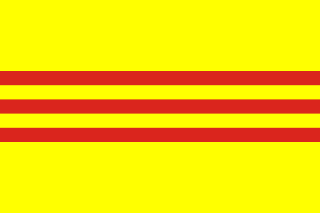
South Vietnam, officially the Republic of Vietnam, was a country in Southeast Asia that existed from 1955 to 1975, the period when the southern portion of Vietnam was a member of the Western Bloc during part of the Cold War after the 1954 division of Vietnam. It first received international recognition in 1949 as the State of Vietnam within the French Union, with its capital at Saigon, before becoming a republic in 1955. South Vietnam was bordered by North Vietnam to the north, Laos to the northwest, Cambodia to the southwest, and Thailand across the Gulf of Thailand to the southwest. Its sovereignty was recognized by the United States and 87 other nations, though it failed to gain admission into the United Nations as a result of a Soviet veto in 1957. It was succeeded by the Republic of South Vietnam in 1975. In 1976, the Republic of South Vietnam and North Vietnam merged to form the Socialist Republic of Vietnam.

The Provisional Revolutionary Government of the Republic of South Vietnam, was formed on June 8, 1969, by the Democratic Republic of Vietnam as an armed underground government opposing the government of South Vietnam under President Nguyễn Văn Thiệu. Delegates of the National Liberation Front of South Vietnam, as well as several smaller groups, participated in its creation.

The Viet Cong was an epithet and umbrella term to call the communist-driven armed movement and united front organization in South Vietnam. Formally organized as and led by the National Liberation Front of South Vietnam and nominally conducted military operations under the name of the Liberation Army of South Vietnam (LASV), the movement fought under the direction of North Vietnam against the South Vietnamese and United States governments during the Vietnam War. The organization had both guerrilla and regular army units, as well as a network of cadres who organized and mobilized peasants in the territory the Viet Cong controlled. During the war, communist fighters and some anti-war activists claimed that the Viet Cong was an insurgency indigenous to the South that represented the legitimate rights of people in South Vietnam, while the U.S. and South Vietnamese governments portrayed the group as a tool of North Vietnam. It was later conceded by the modern Vietnamese communist leadership that the movement was actually under the North Vietnamese political and military leadership, aiming to unify Vietnam under a single banner.

Lê Đức Thọ, born Phan Đình Khải in Nam Dinh Province, was a Vietnamese revolutionary general, diplomat, and politician. He was the first Asian to be awarded the Nobel Peace Prize, jointly with United States Secretary of State Henry Kissinger in 1973, but refused the award.

The Pathet Lao, officially the Lao People's Liberation Army, was a communist political movement and organization in Laos, formed in the mid-20th century. The group ultimately conquered the entire country of Laos in 1975, after the Laotian Civil War. The Pathet Lao were always closely associated and dependent on Vietnamese communists and North Vietnam since their foundation, with the group being established after advice from Hanoi to create a Laotian counterpart of the Viet Minh later Viet Cong. During the civil war, it was effectively organised, equipped and even led by the People's Army of Vietnam (PAVN). They fought against the anti-communist forces in the Vietnam War. Eventually, the term became the generic name for Laotian communists. Under orders from Mao Zedong, the People's Liberation Army provided 115,000 guns, 920,000 grenades and 170 million bullets, and trained more than 700 of its military officers.
Cornelius Mahoney Sheehan was an American journalist. As a reporter for The New York Times in 1971, Sheehan obtained the classified Pentagon Papers from Daniel Ellsberg. His series of articles revealed a secret United States Department of Defense history of the Vietnam War and led to a U.S. Supreme Court case, New York Times Co. v. United States, 403 U.S. 713 (1971), which invalidated the United States government's use of a restraining order to halt publication.
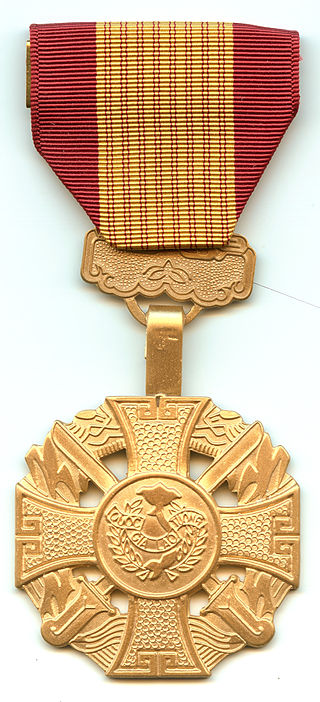
The Republic of Vietnam Gallantry Cross also known as the Vietnamese Gallantry Cross or Vietnam Cross of Gallantry is a military decoration of the former Government of South Vietnam. The medal was created on August 15, 1950, and was awarded to military personnel, civilians, and Armed Forces units and organizations in recognition of deeds of valor or heroic conduct while in combat with the enemy.

The Paris Peace Accords, officially the Agreement on Ending the War and Restoring Peace in Viet Nam, was a peace agreement signed on January 27, 1973, to establish peace in Vietnam and end the Vietnam War. The agreement was signed by the governments of the Democratic Republic of Vietnam ; the Republic of Vietnam ; the United States; and the Provisional Revolutionary Government of the Republic of South Vietnam (PRG), which represented South Vietnamese communists. US ground forces had begun to withdraw from Vietnam in 1969, and had suffered from deteriorating morale during the withdrawal. By the beginning of 1972 those that remained had very little involvement in combat. The last American infantry battalions withdrew in August 1972. Most air and naval forces, and most advisers, also were gone from South Vietnam by that time, though air and naval forces not based in South Vietnam were still playing a large role in the war. The Paris Agreement removed the remaining US forces. Direct U.S. military intervention was ended, and fighting between the three remaining powers temporarily stopped for less than a day. The agreement was not ratified by the U.S. Senate.
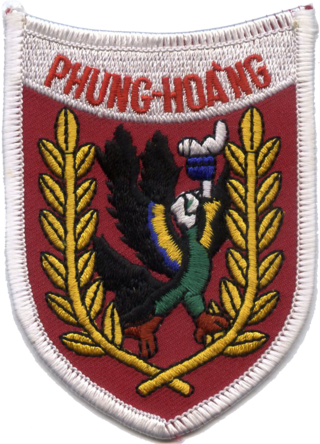
The Phoenix Program was designed and initially coordinated by the United States Central Intelligence Agency (CIA) during the Vietnam War, involving the American, South Vietnamese militaries, and a small amount of Special forces operatives from the Australian Army Training Team Vietnam. In 1970, CIA responsibility was phased out, and the program was put under the authority of the Civil Operations and Revolutionary Development Support (CORDS).

The Best and the Brightest (1972) is an account by journalist David Halberstam of the origins of the Vietnam War published by Random House. The focus of the book is on the foreign policy crafted by academics and intellectuals who were in President John F. Kennedy's administration, and the consequences of those policies in Vietnam. The title referred to Kennedy's "whiz kids"—leaders of industry and academia brought into the administration—whom Halberstam characterized as insisting on "brilliant policies that defied common sense" in Vietnam, often against the advice of career U.S. Department of State employees.

The Republic of Vietnam national football team was the national association football team representing South Vietnam. It also represented the State of Vietnam prior to 1955, and the Republic of South Vietnam in 1975. South Vietnam joined the International Association Football Federation (FIFA) in 1952 and the Asian Football Confederation (AFC) in 1954. The South Vietnamese football association was treated by these bodies as the only legitimate Vietnamese association, as South Vietnam claimed sovereignty over all of Vietnam from 1949 to 1975. The South Vietnam team appeared under French Indochina in 1947, before a Vietnamese government representing it appeared in 1949. After Vietnam gained independence from France and was divided in 1954, it existed side by side with a separate North Vietnam team, which represented the Communist-controlled northern portion of the country from 1956 to 1976. Unlike its southern counterpart, the latter was never allowed to join FIFA or the AFC. South Vietnam took part in the first two Asian Cups finals, finishing last both times.
The following outline is provided as an overview of and topical guide to the Vietnam War:

The Battle of the Paracel Islands was a military engagement between the naval forces of China and South Vietnam in the Paracel Islands on January 19, 1974. The battle was an attempt by the South Vietnamese navy to expel the Chinese navy from the vicinity. The confrontation took place towards the end of the Vietnam War.
Ubon Royal Thai Air Force Base is a Royal Thai Air Force (RTAF) facility located near the city of Ubon Ratchathani, in Ubon Ratchathani Province. It is approximately 488 km northeast of Bangkok. The Laos border is about 60 kilometres (37 mi) directly east. The facility is also used as a civil airport.
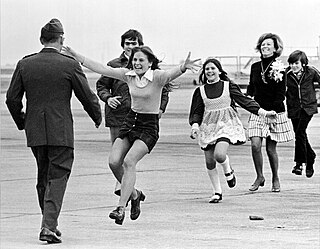
Burst of Joy is a Pulitzer Prize-winning photograph by Associated Press photographer Slava "Sal" Veder, taken on March 17, 1973, at Travis Air Force Base in Solano County, California, United States involving Lt Col Robert L. Stirm and his family.
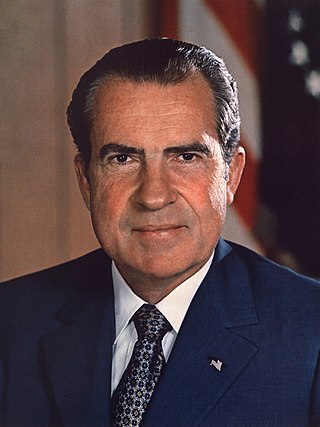
Richard Nixon's tenure as the 37th president of the United States began with his first inauguration on January 20, 1969, and ended when he resigned on August 9, 1974, in the face of almost certain impeachment and removal from office, the only U.S. president ever to do so. He was succeeded by Gerald Ford, whom he had appointed vice president after Spiro Agnew became embroiled in a separate corruption scandal and was forced to resign. Nixon, a prominent member of the Republican Party from California who previously served as vice president for two terms under president Dwight D. Eisenhower, took office following his narrow victory over Democrat incumbent vice president Hubert Humphrey and American Independent Party nominee George Wallace in the 1968 presidential election. Four years later, in the 1972 presidential election, he defeated Democrat nominee George McGovern, to win re-election in a landslide. Although he had built his reputation as a very active Republican campaigner, Nixon downplayed partisanship in his 1972 landslide re-election.
Nguyễn Tiến Hưng was Minister of Economic Development and Planning in the Republic of Vietnam and one of President Nguyễn Văn Thiệu's closest advisers. As of 2010, he is Professor Emeritus of Economics at Howard University in Washington, D.C.

Foreign relations exist between Australia and Vietnam. Australia has an embassy in Hanoi and a consulate in Ho Chi Minh City. Vietnam has an embassy in Canberra.